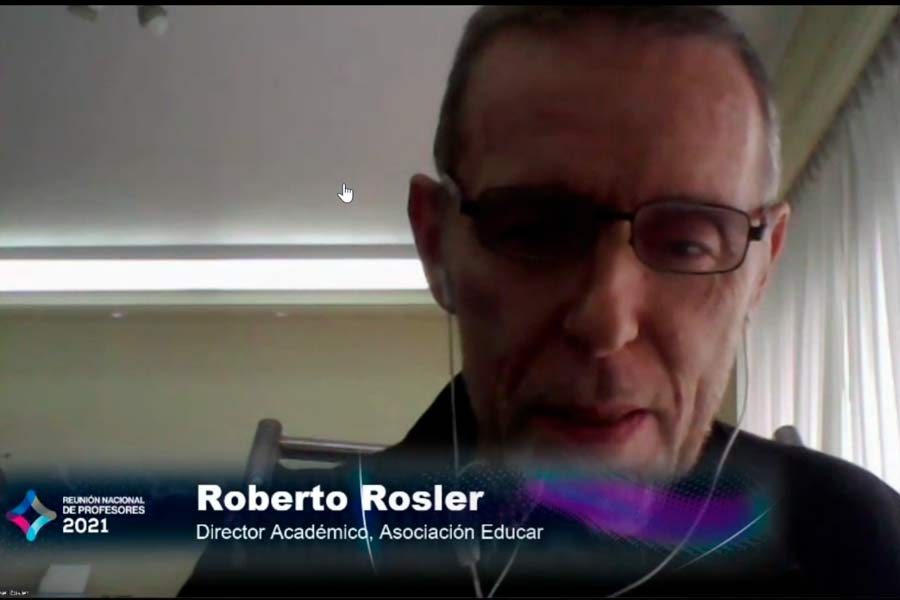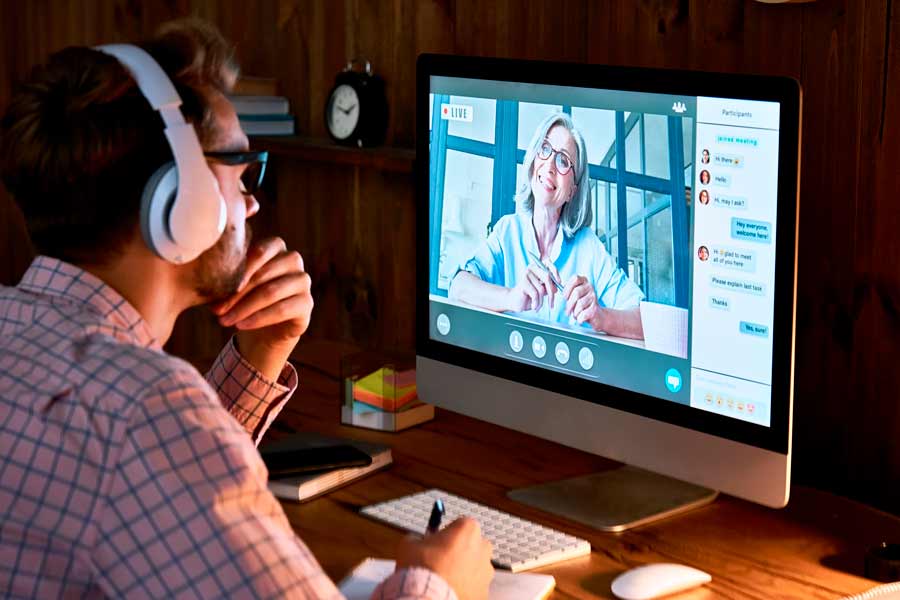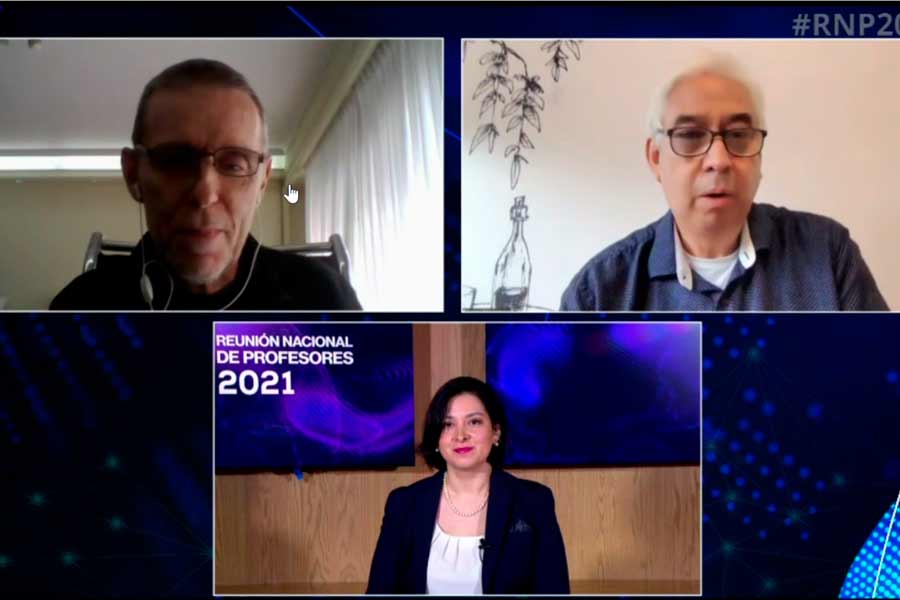“We’re moving to a hybrid model. What should we keep, replace, or acquire in our teaching practice?” asked the speaker Roberto Rosler when addressing professors at Tec de Monterrey.
Rosler, who is a neurosurgeon, professor of neurophysiology, and academic director at Asociación Educar, said that this transition from teaching completely in-person to a hybrid environment was like moving house.
“We’re moving from traditional classrooms to hybrid classrooms, and like any move, it can be a very stressful event or an amazing adventure,” the speaker said.
This was during his keynote speech “We’re moving to a hybrid model: What do we do with what we have?” at the Tec’s 2021 National Teachers’ Conference.

Key questions for the transition to a hybrid model
The speaker said that when “moving house” to a hybrid model, you should ask yourself 4 basic questions:
1. What things do I keep?
- Keep giving personalized treatment and motivation.
By comparing this to moving house, in which you have to gather the things you need to take to a new home, the speaker said that there are elements of traditional classrooms that should remain in the hybrid model.
“Keep the humane and personalized treatment of students because they need emotional support and motivation.
“I always think of motivation as the fertilizer you use when you plant something. Use motivation at the start, not later,” Rosler said.
- Keep giving formative feedback to students.
In addition to this, he pointed out that formative feedback, which means giving constant feedback to students, helps to develop metacognition.
“Metacognition means thinking about our thoughts. Professionals won’t be able to develop positively if they can’t reflect on their thoughts.
“In addition, constant feedback helps students learn to learn,” the speaker added.

2. What things do I throw out?
- Stop teaching students to pass tests.
Rosler, who is also the author of more than 40 scientific publications, suggested that Tec professors should stop making their students work under pressure.
“First, we need to throw out (the strategy of) teaching to pass tests and move on to teaching to learn, changing our focus,” he said.
- Get rid of timed exams. They’re “kryptonite” for learning.
“(Throw out) timed exams. There’s nothing worse for the brain than testing under pressure. It creates stress, which is “kryptonite” for learning and performance.
“If you want to lower your students’ academic performance, it’s very easy: create stress. And timed exams are huge stressors,” the professor added.
“If you want to lower your students’ academic performance, it’s very easy: create stress. And timed exams are huge stressors.”
3. What things do I replace?
- Replace cumulative exams with formative evaluations.
What’s the difference between testing and evaluating? According to the speaker, the Latin roots of “examine” mean to weigh and those of “evaluate” mean to appreciate.
“With the hybrid classroom, it’s a good moment to go from weighing - What do my students “weigh”, a 5, a 6, or 7? - to evaluating students’ knowledge,” he said.
He suggests making formative evaluations using virtual interfaces and tools such as Kahoot!
“It’s an assessment in the hybrid classroom that’s very democratic because it’s equal for all students. With this hybrid model, we have to think about using tools that democratize in-person and virtual students,” he said.
- Change your students’ mindset.
Based on the fact that memory content is forgotten in 30 seconds, Rosler suggested changing the students’ role, using a theoretical class as an example.
“You need to ask your students to go from being passive receivers to active constructors who manipulate information to avoid forgetting it,” he suggested.
“The teacher and students have to expend enormous amounts of energy to pay attention, and unfortunately our prefrontal cortex doesn’t have energy for 5 hours of that, let alone for 24 hours.”
- Translate content programs to the real world.
Rosler said that it’s common for content programs to make students feel “a million miles away” from what their profession is going to be about. That should be changed to an experience that’s closer to reality.
“Real-world programs connect students to relevant topics and their profession, which gives them a lot of motivation.
“Relevant content is that which is related to students’ daily lives and generates huge intrinsic motivation, which is the motivation that matters, not extrinsic motivation,” explained the speaker.
- Make your students autonomous so they “buy” your subject.
For the teacher, autonomy is similar to the difference between renting and buying a car. When people rent a car, they don’t worry if it’s clean or if it has oil, but when they buy it, they take care of it because they made an investment in it.
“This replaces students’ dependence on the teacher by giving them a voice and a vote.
“Students who have no voice in the classroom ‘rent’ the subject. Now, if we give them a voice and a vote and allow them, for example, to choose the bibliography, you tell them there are 5 books and to choose 3, their intrinsic motivation will rise, and they’ll ‘buy’ the subject,” he reflected.
- Lower the RPM of content delivery.
Dr. Rosler suggests implementing a slower speed in the process of teaching students virtually, more in line with their cognitive abilities and the conditions they’re taking classes in.
“Change the speed of delivery, i.e. go from talking at full speed to finish the program to something that the two best neuro-educators of the 21st Century have been telling us for a long time.
“Luis Fonsi and Daddy Yankee, with their song ‘Despacito’, (Slow Down) give us one of the best tips for changing the speed of delivery to something slower. In addition, let’s remember that working memory can process four facts every 20 minutes,” the speaker suggested.
“Luis Fonsi and Daddy Yankee, with their song ‘Despacito’, give us one of the best tips for changing the speed of delivery to something slower.”
4. What new things do I need to acquire for the hybrid classroom?
- Learn how to manage your energy.
The specialist mentioned that the part of the nervous system with “superpowers” or executive functions such as attention is an area that requires a lot of energy.
“The teacher and students have to expend enormous amounts of energy to pay attention, and unfortunately our prefrontal cortex doesn’t have energy for 5 hours of that, let alone for 24 hours.
“We use the little energy we have for paying attention like the battery of a cell phone. When we don’t have sufficient battery for the whole day, we use it more wisely,” he suggested.

- Use the chat to answer questions.
When students are in a virtual situation, according to Rosler, an “epic battle” is fought in their brain when they try to pay attention to the class and, at the same time, try to resolve questions they have from the previous topic.
“There’s no divided attention. The brain can focus on only one thing at a time. On the one hand, they have a question about the previous topic that the teacher taught, but on the other hand, they need to continue paying attention to the class that the teacher is giving.
“From the beginning of the hybrid class model, we installed protocols to resolve virtual students’ questions. A chat is the most active way to respond quickly to students. You’ll surely find a student who wants to coordinate the chat,” he added.
- Keep students alert with a surprise question.
There’s no memory formation if students don’t pay attention, Rosler says. With the use of a cold call or surprise question, they can’t help but be attentive because they become the center of attention.
“It’s calling on virtual students like we do with in-person students, but not with a question they can get right or wrong, but one that asks them to share their opinions or thoughts.
“In addition, with this type of question, the teacher ensures that all voices are heard,” he added.
Bonus tip: Don’t teach more than 4 facts every 20 minutes
Rosler suggested teachers give no more than four facts every 20 minutes, and perhaps less often in the case of a hybrid classroom. This also allows students to rest so that their hippocampus can store that knowledge into memory.
“If we exceed that number, there’s an overload on working memory and absolutely nothing remains in long-term memory,” the professor said.
The professor reflected on the teacher’s challenge in the process of teaching students when working with the “most complex organism in the universe”: the brain.
“We’re moving from traditional classrooms to hybrid classrooms, and like any move, it can be a very stressful event or an amazing adventure.”
He pointed out that although the brain has enormous capacity, the problem is how to place the contents of educational programs into its memory. This requires dealing with two “bottlenecks”.
“The first is called working memory, which has two huge limitations: it processes only four facts every 20 minutes and forgets those facts in 30 seconds.
“The second is the hippocampus, which has the function of learning - weaving our memory - and placing content into long-term memory, but it can’t do both at the same time,” he explained.
Roberto Rosler holds a medical degree from the Faculty of Medicine at the University of Buenos Aires (UBA), where he graduated with honors, and a degree in neurosurgery from the Argentine College of Neurosurgeons. He is a professor of neurophysiology, neuroscience, neuroanatomy, and neuropsychology.
Rosler has taught at universities such as the Pontifical Catholic University of Buenos Aires, the University of Buenos Aires, the School of Medicine at the Italian Hospital of Buenos Aires, and the Open Inter-American University, among others.
“With this hybrid model, we need to think about using tools that democratize in-person and virtual students.”
The National Teachers’ Conference
This is the most important annual event for Tecnológico de Monterrey’s undergraduate and graduate faculty.
Teachers from all National Schools meet to share lessons learned, best practices, and experiences. Activities and forums are set up to address important issues for the next school year.
David Garza, Dean and Executive President of the Tec, thanked teachers for all their work this year.
“At Tec de Monterrey, we stand out thanks to the enthusiasm and dedication that all of you have put in. Thank you for your commitment, and I invite you to continue with that great passion for educating the future leaders who are going to transform our country,” he said.
The National Teachers’ Conference is being held virtually from July 5 to 8.
YOU SHOULD ALSO READ:





